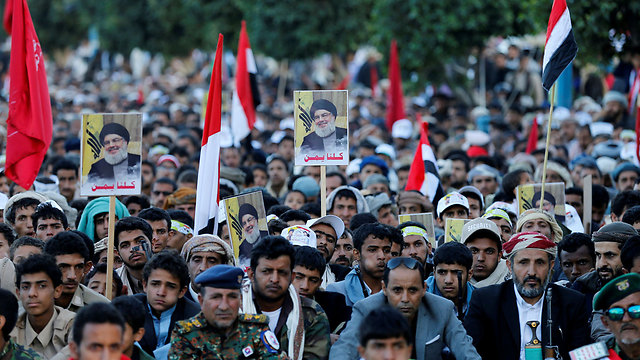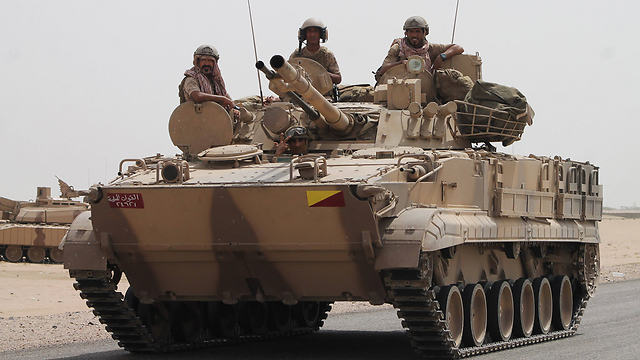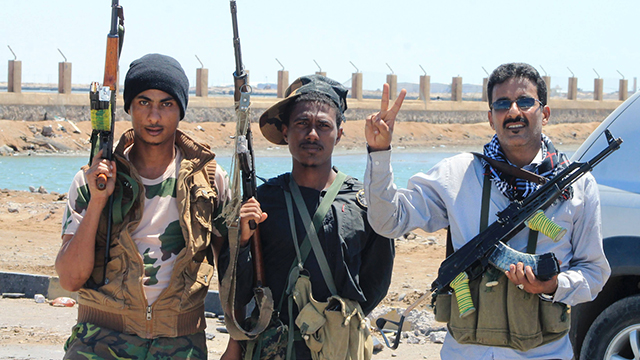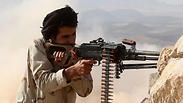
Yemen’s Hezbollah: The Saudi-Israeli problem
Analysis: Saudi Arabia intervened in the war in Yemen in order to avoid having a Shia organization control a state with a shared border. If the Saudis fail to eliminate the Houthi enemy, the day will come when the Houthis start helping Hezbollah and become Israel's problem as well.
How are the two organizations connected? Is Israel’s problem Saudi Arabia’s problem as well?
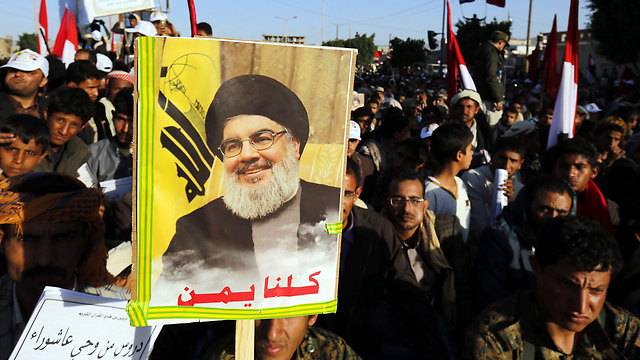
‘Death to America, death to Israel, curse the Jews’
This is the Houthi Yemeni Shias' slogan. Why are the Houthis, who live some 2,200 kilometers away from Israel, cursing the Jews? The answer can be found in the history of the al-Houthi family, which took over the Zaidi Shias in Yemen. Their movement is called Ansar Allah (“Partisans of God”), which is not incidentally similar to the name Hezbollah (“Party of God”). The creation of both movements was inspired by the Iranian Shia revolution, whose slogan was “Death to America and death to Israel.” The colors of the Houthi flag are similar to the colors of Iran’s flag, and both feature the call “Allahu Akbar” (“God is the greatest”).
This year, incidentally, Yom Kippur took place at the same date as the Day of Ashura, the beginning of Islamic year 1438. On this day, the Shia (about 15 percent of all Muslims) mourn the murder of Husayn ibn Ali, Prophet Muhammad’s grandson. Shias around the world believe that this incident, which took place about 1,300 years ago, was the Sunnis’ fault and cannot be forgiven. On the Day of Ashura, the Shias beat themselves to a pulp in order to feel and identify with the suffering of Husayn, who was murdered mercilessly in Karbala, Iraq, 100 kilometers south of Baghdad.
The Sunnis are well aware of the Shias' need to avenge this event and of the hundreds of years of oppression the Shias underwent at the hands of the Sunnis. Ever since the Iranian revolution in 1979, there has been a feeling in the Sunni world that the Shia revenge is taking shape and turning into an Iranian battle to take over the Middle East with the help of the Shia minorities (such as the Druze and the Alawites).
There are Shia groups in Lebanon and Yemen which make up a significant part of the population (about 40 percent in both). Iran established Hezbollah in Lebanon in the 1980s, and it supported the creation of the Ansar Allah organization in Yemen in the 2000s. While the Houthis, unlike Hezbollah, deny any link to Iran and claim that their weapons were obtained independently, the two organizations basically function as arms of Iran.
Hezbollah and Ansar Allah’s similar goals
The two organizations in Lebanon and Yemen were established due to of blatant discrimination, poverty and deprivation of the Shia sect by the ruling regime. But when their power increased, they raised their aspiration to two supreme goals – taking over the state, and becoming the spearhead in Iran’s battle against its two main enemies: Israel and Saudi Arabia.
While Israel is the “Small Satan,” Saudi Arabia is the leader of the eternal enemy – the Sunni Arab world. The Saudi kingdom is controlled by a king who represents the Saudi Sunni school, which is the most radical and most hostile towards the Shias. According to the Iranian perception, this is a religious-political battle between the Shias and the “Great Satan,” the United States – which stands behind Israel and Saudi Arabia – over control of the Middle East.
Iran trying to gain control of Yemen
The wave of Arab revolutions did not skip Yemen and led to the country’s disintegration into tribalism and anarchy. The Houthis saw this as an opportunity to realize their dream to take over Yemen, thereby reaching an even higher position than Hezbollah in Lebanon which only acts as “a state within a state.” Al-Houthi left his stronghold in the northern city of Sa’dah and gradually gained control of areas in western Yemen. In early 2015 he crossed several red lines by conquering and occupying the Yemini capital of Sana’a and progressing towards the port cities in the south, such as Mocha and Aden.
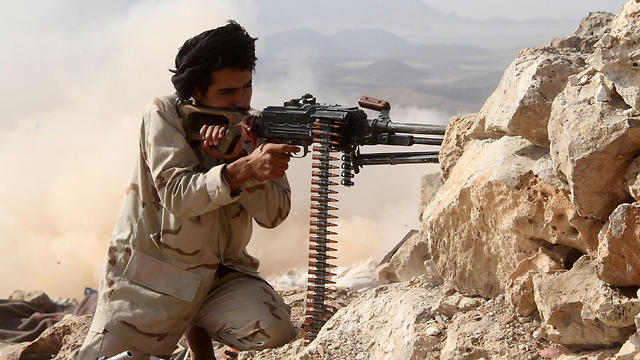
Yemeni President Abdrabbuh Mansour Hadi fled his residence in Sana’a, seeking urgent help to save Yemen. The country appeared to be turning into an Iranian-sponsored Shia stronghold, threatening Saudi Arabia from the south and the sailing routes of the oil tankers leaving the Persian Gulf. This situation could have affected not only the stability in the region, but also the entire world economy.
Saudi Arabia doesn't want to become like Israel
Salman bin Abdulaziz, Saudi Arabia’s relatively new king, decided for the first time in the kingdom’s history to initiate a war using modern American weapons. The Saudis did not want to be in Israel’s situation, in which a Shia organization controls a state with a shared border, occasionally fires missiles at their communities, and threatens the kingdom any time Iran is interested in stirring up trouble.
Despite the impressive coalition established by Saudi Arabia against the Houthis, the kingdom’s nightmare began realizing itself: Missiles were fired as early as last year at Saudi territories, and Saudi soldiers were kidnapped by the Houthis and interrogated in front of cameras.
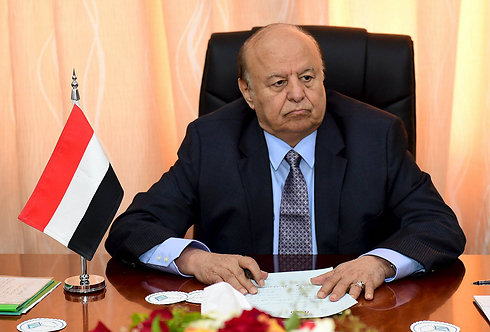
Ali Abdullah Saleh, Yemen’s retiring president, teamed up with the Houthis against Saudi Arabia, which had protected him in the past and offered him medical care. The Saudi coalition, however, demonstrated an impressive ability to unite the Sunni states: Egypt, Morocco, Jordan, Sudan, the United Arab Emirates, Kuwait, Qatar and Bahrain.
The war saved Yemen from falling into the Houthis’ hands and restored Hadi’s rule in the eastern part of the country, centered in the southern port city of Aden. But the war took too long, and the Houthis demonstrated surprising determination. The international criticism over the coalition’s bombings – which have caused the death of hundreds of Yemeni civilians, mostly poor people, and destroyed the country’s infrastructures – increased and reached its peak in the past few months. In March 2016, 22 Yemeni children were killed in a Saudi bombing. Last week, more than 155 people were killed in a bombing on their way to a funeral. The sultanate of Oman has been trying to reach a compromise, but has been unsuccessful so far – and the war continues.
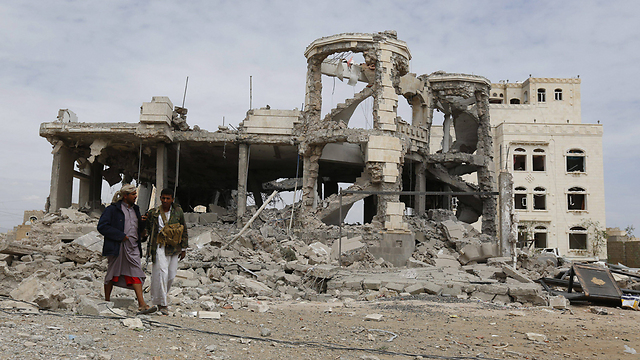
In Syria, the regime and its allies are constantly criticizing what they refer to as a “genocide” committed by Saudi Arabia in Yemen, while they are themselves incessantly murdering the Syrian people. In fact, the two wars – Saudi Arabia’s war in Yemen and the Assad regime’s war in Syria with Hezbollah’s help – are being carried out with unusual cruelty and without differentiating between civilians and terrorists - and the world is keeping silent.
If the Americans had any doubts about their support of the Saudis, the Houthis’ attempts to fire missiles last week at American Navy destroyer USS Mason reminded them of the magnitude of the Shia danger. In response, the Americans bombed Houthi radar sites for the first time.
On Wednesday, in his Day of Ashura speech, Nasrallah created a link between Iran’s two enemies – Saudi Arabia and Israel – and the murder of Yemenis and what he referred to as the “oppression” of the Palestinian people. The Houthis in distant Yemen are insisting that Israel is behind the hostility against them. Is there something they know about the relationship between Israel and Saudi Arabia that we don’t know?
At the moment, Hezbollah is helping the Houthis, but it’s safe to assume that if Saudi Arabia fails to eliminate the Houthi entity, the day will come when the Houthis start helping Hezbollah. If that happens, Saudi Arabia’s problem will be Israel’s problem as well.
Dr. Yaron Friedman, Ynet's commentator on the Arab world, is a graduate of the Sorbonne. He teaches Arabic and lectures about Islam at the Technion, at Beit Hagefen, and at the Galilee Academic College. His book, "The Nusayri Alawis: An Introduction to the Religion, History and Identity of the Leading Minority in Syria," was published in 2010 by Brill-Leiden.










